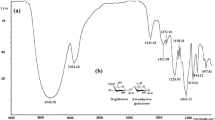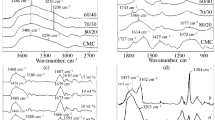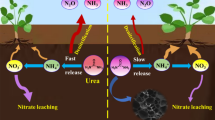Abstract
Gellan gum-chitosan superabsorbent hydrogels were obtained by crosslinking reaction throughout the ionic bond formation. The network formation between high acetyl gellan gum (HAGG) and chitosan (CH) with different proportions was confirmed by FTIR spectra. The thermal stability up to 250 °C was obtained from thermogravimetry and high water swelling from differential scanning calorimetry. It was observed that as the quantity of crosslinks increases, the water sorption and average molecular weight between the crosslinks decrease with a decrease of the HAGG content in the networks. The best results of water absorption of more than 218 times the dry weight of the sample were obtained for the sample HAGG-CH with 4:1 composition. This sample also evidenced the lowest amount of crosslinks when compared with the sample with 1:4 proportion, being 1.1 × 10−4 and 11.1 × 10−4, respectively. The water evaporation analysis showed that the samples retain water for about 500 min, i.e., more than twice as long when compared to 200 min for pure water. Moreover, the HAGG-CH samples were tested as commercial monopotassium phosphate fertilizer-release agents showing that almost complete release occurred in approximately 8 h, and its quantity is mainly influenced by the concentration of fertilizer used rather than the hydrogel composition. Finally, the samples were lyophilized and their morphology analyzed by scanning electron microscopy.










Similar content being viewed by others
References
Agnihotri SA, Aminabhavi TM (2005) Development of novel interpenetrating network gellan gum-poly(vinyl alcohol) hydrogel microspheres for the controlled release of carvedilol. Drug Dev Indust Pharm 31:491–503. doi:10.1080/03639040500215875
Amaike M, Senoo Y, Yamamoto H (1998) Sphere, honeycomb, regularly spaced droplet and fiber structures of polyion complexes of chitosan and gellan. Macromol Rapid Commun 19:287–289
Barikani MH, Hepburn C (1992) Determination of crosslink density by swelling in the castable polyurethane elastomer based on 1/4-cyclohexane diisocyanate and para-phenylene diisocyanate. Iran J Polym Sci Technol 1:1–5
Barker ED (2010) Hydrogel for controlled delivery of biologically active agent comprises dispersed phase including polymeric network comprising hydrolyzable polymeric substance derived from starch, and cross-linker; and dispersion medium containing water. US2010331232-A1
Bortolin A, Aouada FA, de Moura MR, Ribeiro C, Longo E, Mattoso LHC (2012) Application of polysaccharide hydrogels in adsorption and controlled-extended release of fertilizers processes. J Appl Polym Sci 123:2291–2298. doi:10.1002/app.34742
Carlfors J, Edsman K, Petersson R, Jornving K (1998) Rheological evaluation of Gelrite (R) in situ gels for ophthalmic use. Eur J Pharm Sci 6:113–119
Corradini E, de Moura MR, Mattoso LHC (2010) A preliminary study of the incorparation of NPK fertilizer into chitosan nanoparticles. Express Polym Lett 4:509–515. doi:10.3144/expresspolymlett.2010.64
Coutinho DF et al (2010) Modified Gellan Gum hydrogels with tunable physical and mechanical properties. Biomaterials 31:7494–7502
Coviello T et al (1998) A novel co-crosslinked polysaccharide: studies for a controlled delivery matrix. J Controlled Rel 55:57–66
Dai YN, Li P, Zhang JP, Wang AO, Wei Q (2008) Swelling characteristics and drug delivery properties of nifedipine-loaded pH sensitive alginate-chitosan hydrogel beads. J Biomed Mater Res B 86B:493–500. doi:10.1002/Jbm.B.31046
Ferris CJ, Panhuis MIH (2009) Conducting bio-materials based on gellan gum hydrogels. Soft Matter 5:3430–3437. doi:10.1039/b909795c
Flory PJ, Rehner J (1943) Statistical mechanics of cross-linked polymer networks II Swelling. J Chem Phys 11:521–526. doi:10.1063/1.1723792
Giavasis I, Harvey LM, McNeil B (2000) Gellan gum. Crit Rev Biotechnol 20:177–211
Guo MY, Liu MZ, Hu Z, Zhan FL, Wu L (2005) Preparation and properties of a slow release NP compound fertilizer with superabsorbent and moisture preservation. J Appl Polym Sci 96:2132–2138. doi:10.1002/app.21140
Guzman-Villanueva D, Smyth HDC, Herrera-Ruiz D, El-Sherbiny IM (2011) A novel aerosol method for the production of hydrogel particles. J Nanomater. doi:10.1155/2011/507508
Hatakeyema T, Yamauchi A, Hatakeyema H (1984) Studies on bound water in polyvinyl-alcohol)-hydrogel by DSC and FT NMR. Eur Polym J 20:61–64
Jansson PE, Lindberg B, Sandford PA (1983) Structural studies of gellan gum, an extracellular polysaccharide elaborated by Pseudomonas-elodea. Carbohydr Res 124:135–139
Malaise S et al (2014) Bioresorption mechanisms of chitosan physical hydrogels: a scanning electron microscopy study. Mat Sci Eng C Mater 42:374–384. doi:10.1016/j.msec.2014.04.060
Milas M, Shi X, Rinaudo M (1990) On the physicochemical properties of gellan gum. Biopolymers 30:451–464
Noor ISM, Majid SR, Arof AK, Djurado D, Pawlicka A (2012) Characteristics of gellan gum—LiCF3SO3 polymer electrolyte. Solid State Ion 225:649–653. doi:10.1016/j.ssi.2012.03.019
Ohkawa K, Kitagawa T, Yamamoto H (2004) Preparation and characterization of chitosan-gellan hybrid capsules formed by self-assembly at an aqueous solution interface. Macromol Mat Eng 289:33–40. doi:10.1002/mame.200300188
Omidian H, Zohuriaan-Mehr MJ (2002) DSC studies on synthesis of superabsorbent hydrogels. Polymer 43:269–277. doi:10.1016/S0032-3861(01)00546-8
Ostrowska-Czubenko J, Gierszewska-Druzynska M (2009) Effect of ionic crosslinking on the water state in hydrogel chitosan membranes. Carbohydr Polym 77:590–598
Paulsson M, Edsman K (2002) Controlled drug release from gels using lipophilic interactions of charged substances with surfactants and polymers. J Coll Interface Sci 248:194–200. doi:10.1006/jcis.2001.8182
Pawlicka A, Donoso JP (2010) Polymer electrolytes based on natural polymers. In: Sequeira CAC, Santos DMF (eds) Polymer electrolytes: properties and applications. Woodhead Publishing Limited, Cambridge, pp 95–128
Ramaiah S, Kumar TMP, Ravi V (2007) Studies on biopolymers for ophthalmic drug delivery. J Macromol Sci A 44:229–234. doi:10.1080/10601320601031416
Wasikiewicz JM, Mitomo H, Nagasawa N, Yagi T, Tamada M, Yoshii F (2006) Radiation crosslinking of biodegradable carboxymethylchitin and carboxymethylchitosan. J Appl Polym Sci 102:758–767
Wu L, Liu MZ (2008) Preparation and properties of chitosan-coated NPK compound fertilizer with controlled-release and water-retention. Carbohydr Polym 72:240–247. doi:10.1016/j.carbpol.2007.08.020
Yamamoto H, Senoo Y (2000) Polyion complex fiber and capsule formed by self-assembly of chitosan and gellan at solution interfaces. Macromol Chem Phys 201:84–92
Yang C et al (2010) A green fabrication approach of gelatin/CM-chitosan hybrid hydrogel for wound healing. Carbohydr Polym 82:1297–1305. doi:10.1016/j.carbpol.2010.07.013
Yoshimura T, Matsuo K, Fujioka R (2006) Novel biodegradable superabsorbent hydrogels derived from cotton cellulose and succinic anhydride: synthesis and characterization. J Appl Polym Sci 99:3251–3256
Zhang GQ, Zha LS, Zhou MH, Ma JH, Liang BR (2005) Preparation and characterization of pH- and temperature-responsive semi-interpenetrating polymer network hydrogels based on linear sodium alginate and crosslinked poly(N-isopropylacrylamide). J Appl Polym Sci 97:1931–1940. doi:10.1002/app.21957
Acknowledgments
The financial support of the Brazilian agencies CNPq, Capes and FAPESP is gratefully acknowledged.
Author information
Authors and Affiliations
Corresponding author
Rights and permissions
About this article
Cite this article
Sabadini, R.C., Martins, V.C.A. & Pawlicka, A. Synthesis and characterization of gellan gum: chitosan biohydrogels for soil humidity control and fertilizer release. Cellulose 22, 2045–2054 (2015). https://doi.org/10.1007/s10570-015-0590-6
Received:
Accepted:
Published:
Issue Date:
DOI: https://doi.org/10.1007/s10570-015-0590-6




